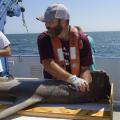Marine Resources
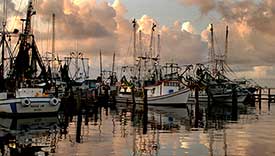
Marine-related resources support a variety of enterprises along the Mississippi-Alabama coast, ranging from the seafood industry to eco-tourism, and these resources contribute significantly to an intangible, but highly valued, quality of life. Mississippi and Alabama face major challenges in managing fisheries, rehabilitating coastal wetlands, protecting coastal water quality, and maintaining stable shorelines. Although covering a relatively small geographic area, the coastal region is one of the fastest growing in the United States. Year after year, more pressure will be put on our beaches, wetlands, fisheries, and the health of our coastal and marine environment.
The coastal area includes: the Mobile Bay estuary with its 43,600 square mile watershed (sixth largest in the nation) and 450,000 gallon per second river discharge (fourth largest); Mississippi Sound (113 square miles); 50 miles of barrier islands; and Perdido Bay (12 square miles, 1,868 square mile watershed). Mobile Bay, Perdido Bay and Mississippi Sound provide ready access to the Gulf of Mexico. Three major seaports, the Port of Mobile, the Port of Pascagoula, and the Port of Gulfport, are located in the region along with major military installations and shipyards. Major embayments within the Mississippi coastal estuarine system are Heron Bay, Bay of St. Louis, Biloxi Bay, Biloxi Back Bay, Pascagoula Bay, and Point Aux Chenes Bay. Of the 74 major river estuaries in North America, the Pascagoula River is the only one in the United States that is unaffected by river channel fragmentation and flow regulation along its entire length. The high biological productivity of this region is an important contributing factor to the substantial seafood industry and overall quality of life for coastal residents. The estuarine area is also under the influence of the Mississippi River drainage system.
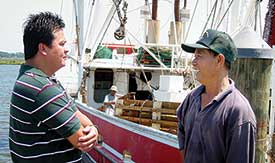
Recreation and tourism in coastal Mississippi and Alabama have a major economic impact. Attractions for tourists are the mild climate, sand beaches, and variety of vacationing opportunities, which include recreational use of the beach, as well as saltwater and freshwater fishing, golfing, casino gambling, and water sports. Coastal tourism accounts for approximately one-third of the total tourism expenditures in the two states. The Mississippi-Alabama coast is also home to many new members of the retirement community who are lured by the climate, low cost of living, and amenities, such as numerous golf courses and excellent fishing. Alabama and Mississippi visitors and residents are becoming more environmentally literate and recognize the importance of low-impact tourism on the diverse natural habitats. Ecotourism involves public and private entities such as state parks and private businesses. There are expanding opportunities to create new ecotourism jobs, especially in coastal areas. There are also opportunities to improve the profitability of existing ecotourism businesses. In the coastal region, many communities long recognized for fishing and farming are experiencing demographic changes as the middle- and upper-class residents move to these areas. The displacement of fishing and farming by service and factory jobs creates opportunities for an expanded ecotourism industry.
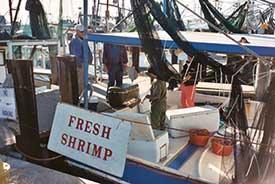
In addition to being the cultural and historical foundation for many communities, the Mississippi-Alabama seafood industry is a major contributor to the regional economy. The main fishing port, Bayou La Batre, is ranked 19th in the nation in value of landings and is the 5th most important port in the Gulf of Mexico. Some 1,500 commercial fishing boats work out of Mississippi and Alabama, employing an estimated 3,000 fishermen.
Seafood landings and seafood imports support over 108 Alabama and Mississippi seafood processing plants and wholesale operations that provide employment for some 5,000 year-round personnel and approximately 2,600 additional seasonal workers. The total economic impact from landings and processing is estimated to be in excess of a billion dollars annually. Alabama and Mississippi processors continue to produce value-added products well in excess of local landings. Landings from state waters are not sufficient to sustain a viable seafood processing industry of this size. As a consequence, Mississippi and Alabama seafood processors handle landings of fishery products from other states and import substantial quantities from foreign countries to sustain plant capacity. Almost 70 percent of the seafood products consumed in the United States (90 percent of the shrimp in particular) is imported, resulting in a trade deficit exceeding $9 billion. The rapid growth in imports of pond-raised shrimp from China and Southeast Asia, as well as expansion in Mexico and in other Central and South American countries, has dramatically changed the price structure and stability of the Gulf shrimp industry. Importation of foreign products from capture fisheries may alleviate the shortfall temporarily; however, increased fishing pressure on finite natural resources will ultimately reduce availability.
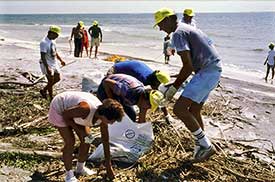
The recreational fishing industry has a significant economic impact on the coastal economy in Mississippi and Alabama. The influx of outside money spent on bait, fuel, tackle, food and lodging represents new money in the economy as opposed to merely a redistribution of disposable income from coastal residents. The growth in recreational fishing participation is expected to increase by 18.5 percent by the year 2025. As an increasing numbers of users compete for finite fishery resources, many fish stocks are at or over their limits of exploitation. Depletion of shallow-water fishery resources and increased regulation of these fisheries have generated interest in new fishery resources, enhancement of depleted stocks, creation of habitat to increase production, and aquaculture. Fisheries for many species in the Gulf of Mexico exhibit wide annual population fluctuations. While a variety of factors have been identified as contributing to variations in population abundance (quantity and quality of habitat, fishing pressure, environmental parameters, pollution) there is little specific data on the relative importance of these factors to individual species population dynamics.
Coastal aquaculture frequently involves new species, product forms, or production technologies. Because research and development efforts have been focused on production, little attention has been paid to linking aquaculture with existing support services or to developing needed infrastructure. Essential seafood services such as processing, storage, transportation, financing, insurance, and personnel training already exist in the coastal region. A key constraint to development is the lack of linkage between aquaculture and existing seafood industries. There is renewed interest in aquaculture and offshore cage culture to supplement to domestic fisheries products. Expansion of these activities would increase product availability and provide economic opportunities in the seafood industry. Stock and habitat enhancement research may also provide a means to maintain or increase fisheries production. For recruitment-limited species with adequate habitat, stock enhancement may aid in stock recovery and fishery stability. Offshore mariculture operations in the Gulf of Mexico so far have not been able to meet the three key criteria for sustainable development: 1) long-term productivity leading to stable markets; 2) profitability for owners and investors; and 3) environmental “friendliness”. However, new technologies as well as increasing regulation of shore-based operations may lead to the development of an offshore industry within the next decade. The most promising short-term aquaculture activity is the production of live bait species used by the region’s substantial sport-fishing industry.
Issues related to loss, alteration and degradation of coastal wetlands are often controversial and decisions made by regulatory agencies concerning protection and conservation of coastal ecosystems will have far-reaching implications for the future. While awareness of environmental issues has increased, true understanding of the issues as they relate to coastal and marine resources is sometimes complicated by the nature of science itself. Gains in understanding are incremental rather than revolutionary and results that are valid today may be modified or overturned as the scientific process evolves. This is particularly true in issues related to living marine resources.
Publications
News
RAYMOND, Miss. -- By 2050, the world’s oceans will contain more plastic pollution by weight than fish. It's an alarming statistic. Implementing small lifestyle changes associated with zero waste can help reduce all waste, including plastics, that enter waterways and landfills.
STARKVILLE, Miss.—As a father of three, Marcus Drymon has watched his fair share of Disney movies, but he never imagined his work as an associate Extension professor at Mississippi State Universit
Success Stories
In late February, Mississippi State University hosted the 2024 National Floriculture Forum, an annual conference held at different locations around the country.
Mississippi State University and partners have been awarded a grant of nearly $6.6 million from the National Fish and Wildlife Federation for shoreline restoration work on the Gulf Coast.
The Application Guide was created by a writing team of Extension and engagement professionals across the country, and Dr. Renee Collini was the lead author.



